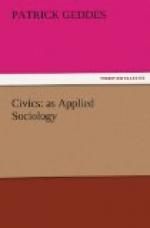A—THE GEOGRAPHIC SURVEY OF CITIES
Coming to concrete Civic Survey, where shall we begin? Not only in variety and magnitude of civic activities, but, thanks especially to the work of Mr. Charles Booth and his collaborators in actual social survey also, London may naturally claim pre-eminence. Yet even at best, does not this vastest of world cities remain a less or more foggy labyrinth, from which surrounding [Page: 105] regions with their smaller cities can be but dimly descried, even with the best intentions of avoiding the cheap generalisation of “the provinces”? For our more general and comparative study, then, simpler beginnings are preferable. More suitable, therefore, to our fundamental thesis—that no less definite than the study of races and usages or languages, is that of the groupings of men—is the clearer outlook, the more panoramic view of a definite geographic region, such, for instance, as lies beneath us upon a mountain holiday. Beneath vast hunting desolations lie the pastoral hillsides, below these again scattered arable crofts and sparsely dotted hamlets lead us to the small upland village of the main glen: from this again one descends to the large and prosperous village of the foothills and its railway terminus, where lowland and highland meet. East or west, each mountain valley has its analogous terminal and initial village, upon its fertile fan-shaped slope, and with its corresponding minor market; while, central to the broad agricultural strath with its slow meandering




